Day 2 of a long weekend of tours today, and we headed down to the Brecks for a day of Stone Curlews, Cranes & Bitterns. It certainly lived up to billing, on a lovely sunny day with just enough of a fresh breeze to stop it getting too hot.
We met in north Norfolk and headed south. We made a quick stop off on the way down to see if we could find any Stone Curlews. As well as the heathland remnants in the Brecks, many pairs nest in farmland in the surrounding countryside. However, they can be easier to see earlier in the year here, before the crops get so high. Their favoured fields were also very disturbed this morning with farming activity – several tractors and people walking around – so we moved swiftly on. We did have two Red Kites circling low over our heads.
 Red Kite – one of two which came low overhead this morning
Red Kite – one of two which came low overhead this morning
Our first destination proper was Lakenheath Fen. It was already getting warm by the time we got there. Warbler activity is significantly lower at this time of the year compared to the spring – yet we still heard a couple of Whitethroats, a Blackcap, and several Reed and Sedge Warblers as we walked out along the path into the reserve.
New Fen appeared very quiet initially as well, with little in view except a couple of juvenile Coots. Then a shrill call alerted us to an incoming Kingfisher. It flew in and landed initially on the perch right in front of the viewpoint, but unfortunately it saw us and decided not to linger there. Still, it landed again on the reeds a little further back across the pool and we had great views of it in the scope. It dropped into the water with a splash and came up with a fish in its bill. Not stopping, it flew off into the trees behind us in a flash of electric blue – it obviously still has young in the nest to feed. Then a second Kingfisher appeared on the pool.
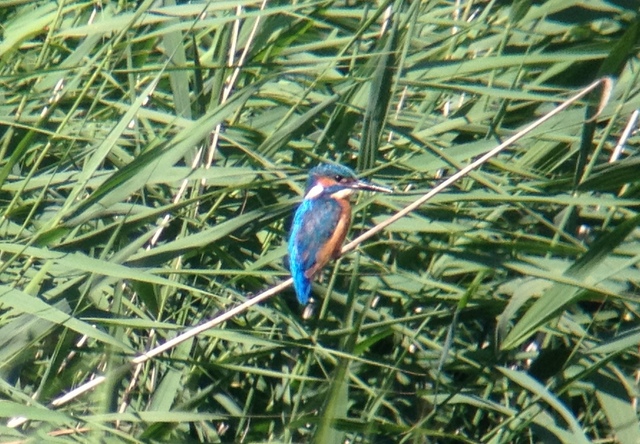 Kingfisher – several birds were fishing around New Fen today
Kingfisher – several birds were fishing around New Fen today
It was while we were watching the Kingfisher, that we suddenly heard crashing in in the reeds right in front of us. The next thing we knew, a Bittern flew out! It only flew a few metres and landed again on the edge of the reeds. It stood there for a second, looking around, then tried to walk into the reeds. It was obviously not easy going because it stopped, had another look round and decided it needed to persevere, and then finally pushed its way into the vegetation and out of view. Fantastic views and a great start. A short while later, another Bittern flew over the back of New Fen and dropped down into the reeds.
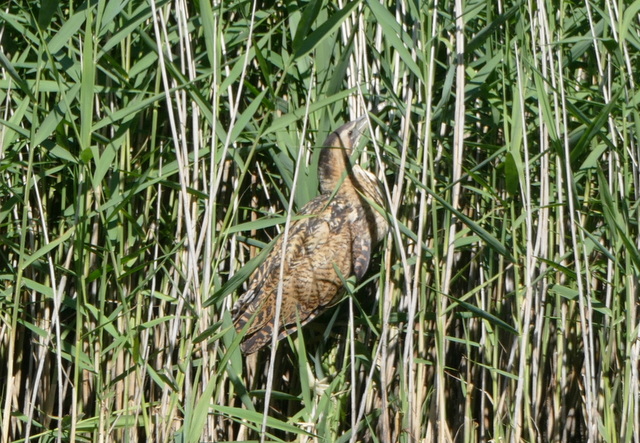 Bittern – landed on the edge of the reeds in front of us…
Bittern – landed on the edge of the reeds in front of us…
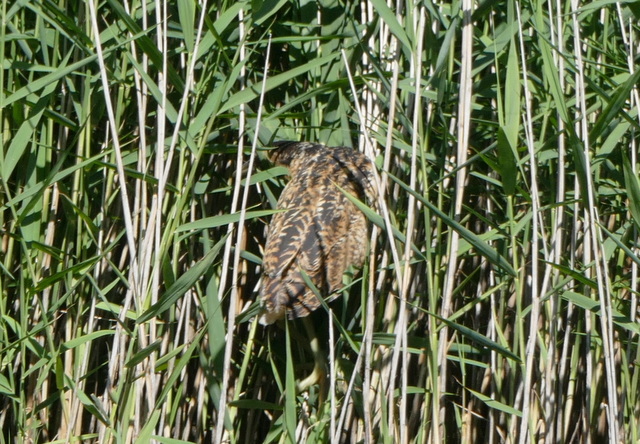 …tried to push its way in, before having second thoughts…
…tried to push its way in, before having second thoughts…
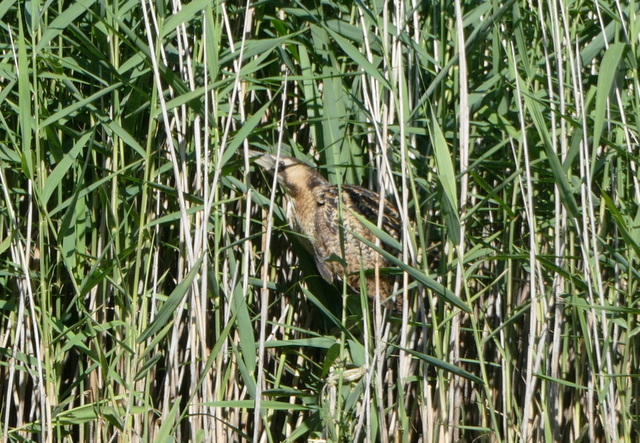 …had another look round before finally working its way out of view.
…had another look round before finally working its way out of view.
There were several Reed Warblers singing around the pool. They can be very good mimics and one in particular began each burst of song with a convincing copy of a Bearded Tit pinging. Finally, as we were about to leave, a Bearded Tit proper appeared, flying across the pool, but it disappeared quickly into the reeds on the island.
We headed on across the reserve. There were lots of dragonflies in the vegetation along the edge of the path – Brown & Southern Hawkers, Black-tailed Skimmers and Ruddy Darters, plus Blue-tailed, Common Blue & Azure Damselflies. There were plenty of butterflies too – Meadow Browns, Ringlets, Gatekeepers, Red Admirals, Small Tortoiseshells, Commas and a single Small Copper.
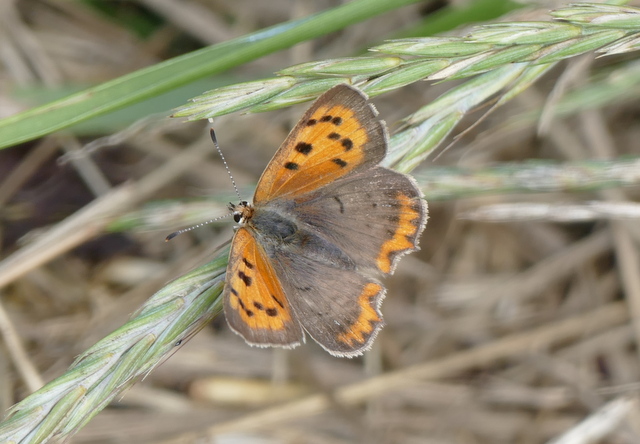 Small Copper – one of many butterflies around the reserve today
Small Copper – one of many butterflies around the reserve today
As we walked along the main path past the West Wood, a glance to the north and we caught sight of four Cranes circling up from the fields the other side of river. There are two pairs of Cranes at Lakenheath Fen and both have fledged young this year – one pair raised two, and the other one chick. This is great news as they had struggled to raise any in the last couple of years. We presumed that this was one of the two families flying but they quickly disappeared from view behind the trees.
From the Joist Fen Viewpoint we could see several Marsh Harriers circling out over the reeds, and it was also good to see several juveniles amongst them. It was while we were watching these that one of the group spotted a Bittern flying behind us, from the reeds over towards the West Wood. We all got onto it and had great views as it set off on a very long flight, all the way along the river bank and out across Joist Fen almost to the far west end. As it got near to its destination, we could see a second Bittern flying round in the same area. The two landed in much the same place – the first bird dropping in shortly after, where we had seen the first disappear.
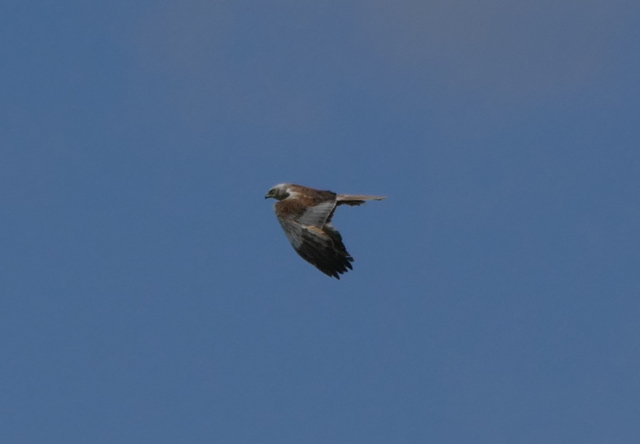 Marsh Harrier – this smart male flew past us on the river bank
Marsh Harrier – this smart male flew past us on the river bank
After a brief sit down at the Joist Fen Viewpoint, we climbed up onto the river bank to see if we could see the Cranes again. We walked along slowly, scanning the fields across on the other side of the river which the Cranes favour, but at first there was no sign – it looked like the four Cranes we had seen earlier might have continued flying. We were just about to give up when one of the group spotted a head amongst the tall vegetation. We got the scopes onto it, and gradually saw more heads come up. We could see that at least one juvenile was amongst them, but it was only when we eventually saw two juvenile heads up at the same time that we could confirm this was the family of four Cranes. They were a little distant, but we still got good views of them through the scopes.
With that target achieved, we set off on the walk back. We were just about to drop down from the river bank back onto the reserve when we noticed three more Cranes flying away from us, over the fields on the other side of the river. They landed several fields over, rather a long way off but we could still see that there were two adults and a single juvenile – the second Crane family. It was great to be able to see all seven of Lakenheath’s Cranes today!
We had a quick look in at New Fen on the way back, but there was no sign of the Bittern in the reeds around the pool. A Kingfisher was still fishing around the reed edge. We were almost back to the Visitor Centre, when we caught a very brief snatch of Grasshopper Warbler song. We stopped and heard it again a couple of times, but it was rather quiet, possibly distant, and unfortunately we couldn’t see any sign of it in the bushes. A little further along, a Weasel ran ahead of us along the path.
After lunch, we headed over to Weeting Heath. We could hear Stone Curlews calling as soon as we got out of the car. Round at the hide, we could immediately see several Stone Curlews out in the grass. A single adult was together with two well-grown juveniles a little further over towards the ridge, but then we noticed two adults on the cultivated area not far from the front of the hide. Even better, it clouded over just a little, just enough to relieve the heat haze which is an ever present at this site. We got the scopes on them and had great views, admiring their somewhat prehistoric appearance and staring pale iris.
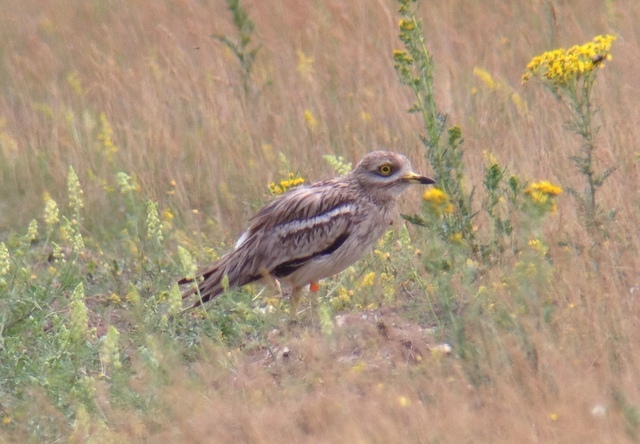 Stone Curlew – great views at Weeting Heath today
Stone Curlew – great views at Weeting Heath today
Having admired the closest Stone Curlews preening and walking slowly through the grass, they sat down and merged into the vegetation. We then had time to scan the rest of the grass and could see several more birds scattered across the ridge further over. We counted at least nine Stone Curlews here today, including the juveniles – there are three pairs on site and some young have already fledged. It was great to see the Stone Curlews so well, but unfortunately the Firecrests and Spotted Flycatchers here both appear to have fledged their young in the last couple of weeks and the pines were rather quiet, so we didn’t spend long here.
Next we headed into the Forest and walked out along one of our favourite rides. It was a bit hotter in the afternoon, and there was less benefit from the breeze in the shelter of the trees. Perfect conditions for butterflies and there were lots on the flowers along the sides of the track. It was nice to see both Small & Essex Skippers, a few Small Heath and several more Small Copper.
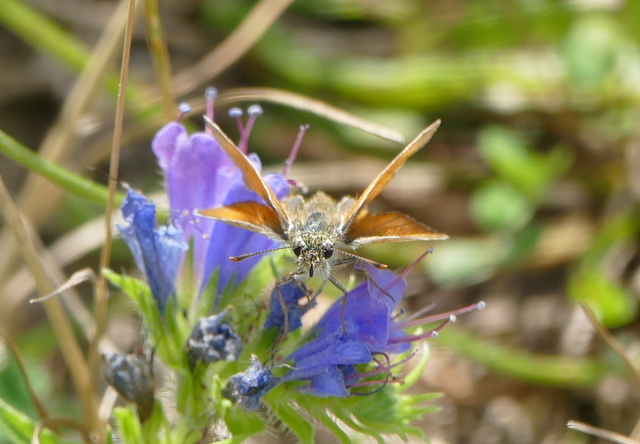 Small Skipper – head on, showing the diagnostic pale antenna tips
Small Skipper – head on, showing the diagnostic pale antenna tips
In a large clearing, we immediately saw lots of activity around the overgrown, rowed up tree stumps. Perched on the very top of the stumps, we could see a male and female Stonechat. In amongst them, we could see a couple of Yellowhammers, Whitethroats and two Tree Pipits.
We walked round to the other side to get a closer look. As well as the male & female Stonechats, we could also see at least two juveniles. They were trying to hide more in the vegetation, less inclined to perch on the tops than the adults. However, on closer inspection we could see that the juvenile Stonechats were colour ringed, part of an ongoing ringing programme in the Brecks.
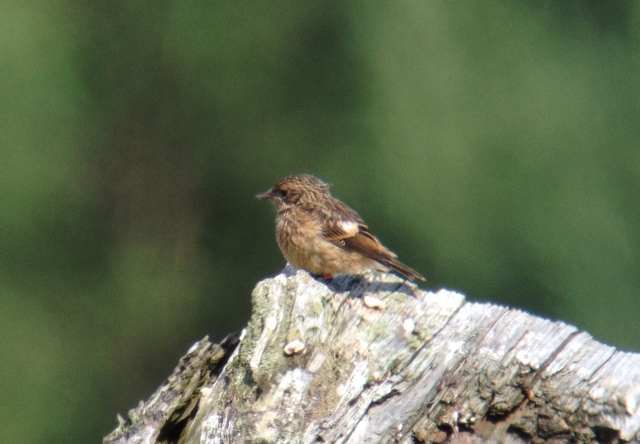 Stonechat – one of two colour-ringed juveniles in the clearing
Stonechat – one of two colour-ringed juveniles in the clearing
The Tree Pipits had been chasing each other around and had appeared to fly off. As we walked around the edge of the clearing, we flushed one from beside the path. It flew off calling with a loud ‘speezz’, into the pine trees where it sat for a few seconds before dropping back into the grass and out of view. While we were watching the Stonechats, one of the Tree Pipits suddenly appeared back with them, perched on a stump below them and half hidden from view. When the Stonechats moved off, it flew up to the top and started to preen, giving us a great look. We could see a pale spot on the face, the yellowing wash behind the bolder streaking across the breast and the very fine streaking on the flanks.
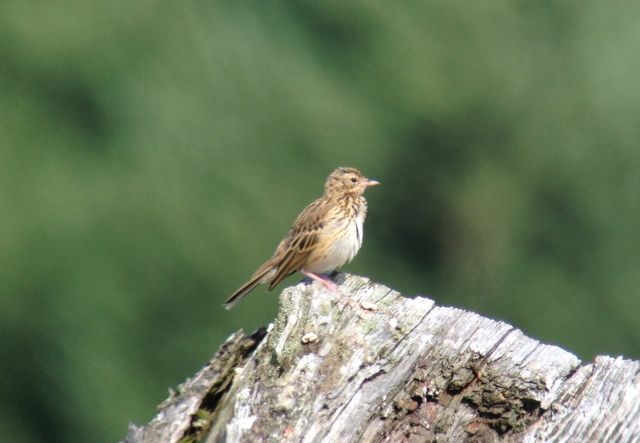 Tree Pipit – perched up on a stump once the Stonechats had moved on
Tree Pipit – perched up on a stump once the Stonechats had moved on
We just had time for one last and very brief stop on our way back, so we popped into Lynford Arboretum. A Treecreeper was calling in the car park but it was rather quiet in the trees,in the heat of a sunny summer afternoon. A couple of Siskin flew overhead calling. Down by the bridge, there was a bit more activity. We came across a big mixed tit flock, and watched it for a while in the alders. There were lots of Long-tailed Tits, plus Blue, Great and Coal Tits, several Treecreepers and a Nuthatch as the flock moved through. We could also hear a Goldcrest singing. We didn’t really have time to do the site justice today and all too soon it was time to call it a day and head for home.

















